Nybörjare frågar oss ofta om de kan flytta sina webbplatser till SSL eller HTTPS. Termerna låter kanske för tekniska, men det är faktiskt väldigt enkelt att göra.
HTTPS i webbadressen till en webbplats innebär att den använder ett säkert dataöverföringsprotokoll genom att installera ett SSL-certifikat. Detta är viktigt eftersom de flesta moderna webbläsare visar varningar för webbplatser som inte använder HTTPS.
Lyckligtvis gör de flesta pålitliga webbhotell och WordPress det mycket enkelt att säkra din webbplats.
I den här artikeln kommer vi att visa dig hur du flyttar din WordPress från HTTP till HTTPS genom att lägga till ett SSL-certifikat. Oroa dig inte om du inte vet vad SSL eller HTTPS är. Vi kommer att förklara det också.
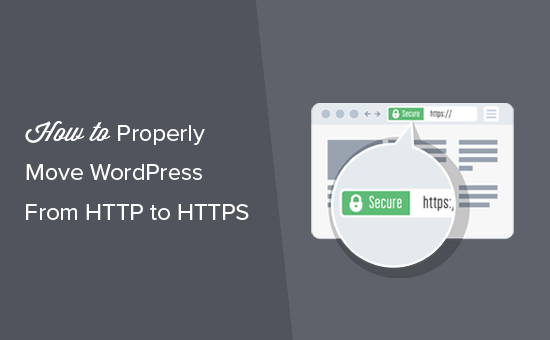
Här följer en snabb översikt över de ämnen som vi kommer att behandla i den här artikeln:
- What Is HTTPS?
- Why Do You Need HTTPS and SSL?
- Requirements for Using HTTPS/SSL on a WordPress Site
- Setting Up WordPress to Use SSL and HTTPS
- Method 1: Setup SSL/HTTPS in WordPress Using a Plugin
- Method 2: Set Up SSL/HTTPS in WordPress Manually
- Submit Your HTTPS Site to Google Search Console
- Bonus Resources
- Video Tutorial
Vad är HTTPS?
HTTPS, eller Secure HTTP, är en krypteringsmetod som säkrar anslutningen mellan en användares webbläsare och din server. Denna extra säkerhet gör det mycket svårare för hackare att fånga upp de data som överförs.
Varje dag delar människor med sig av personliga uppgifter till webbplatser, oavsett om de gör inköp eller bara loggar in. Vi har själva sett hur viktigt det är att skydda den här typen av datautbyte.
För att säkerställa datasäkerheten måste en säker anslutning upprättas.
Det är här SSL och HTTPS kommer in i bilden.
Varje webbplats får ett unikt SSL-certifikat för identifiering. Om en server försöker använda HTTPS utan ett giltigt certifikat eller om certifikatet inte matchar, kommer de flesta moderna webbläsare att varna användarna och avråda dem från att fortsätta.
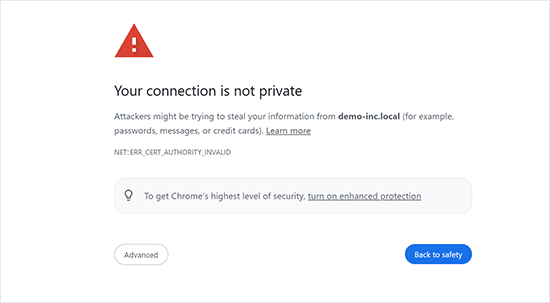
Nu kanske du undrar varför det är nödvändigt att flytta din WordPress-webbplats från HTTP till HTTPS, särskilt om det är en enkel blogg eller en webbplats för småföretag som inte hanterar betalningar.
Varför behöver du HTTPS och SSL?
Redan 2018 tillkännagav Google ett initiativ för att öka webbsäkerheten genom att uppmana webbplatsägare att byta från HTTP till HTTPS. För att obsługa detta började webbläsaren Chrome markera alla webbplatser utan SSL-certifikat som “inte säkra”.
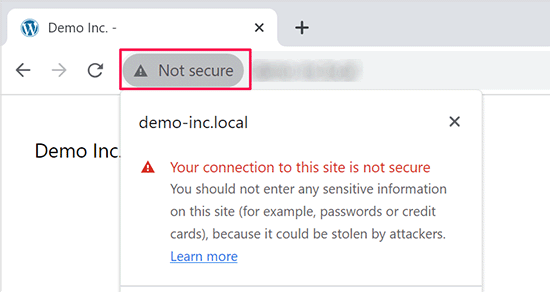
Google nämnde också att webbplatser med SSL skulle få SEO-fördelar och kunna uppnå högre sökrankning än icke-säkra webbplatser. Detta tillkännagivande fick många webbplatsägare att byta till HTTPS.
När “Inte säkert”-varningen rullades ut började Chrome flagga HTTP-webbplatser. Om du till exempel besöker en HTTP-webbplats i inkognitoläge eller fyller i ett kontaktformulär på en HTTP-webbplats utlöses varningen, vilket markerar den som osäker.
När besökare ser denna varning kan det ge ett negativt intryck av din webbplats eller ditt företag.
Det är därför alla webbplatser måste övergå till HTTPS och installera SSL så snart som möjligt.
Dessutom är SSL ett måste om du vill acceptera onlinebetalningar på din webbplats för e-handel.
Betalningsleverantörer som Stripe, PayPal Pro och Authorize.net kräver en säker betalningsanslutning.
Vi ser till att våra egna webbplatser använder SSL, inklusive WPBeginner, OptinMonster, WPForms och MonsterInsights.
Obligatoriska krav för användning av HTTPS/SSL på en site i WordPress
Kraven för att använda SSL i WordPress är ej särskilt höga. Allt du behöver göra är att köpa ett SSL-certifikat, och du kanske redan har det gratis.
De bästa företagen för webbhotell WordPress erbjuder gratis SSL-certifikat för alla sina användare:
För mer detaljer, se vår guide om hur du skaffar ett gratis SSL-certifikat för din website i WordPress.
Om ditt webbhotell inte erbjuder ett kostnadsfritt SSL-certifikat måste du köpa ett.
Vi rekommenderar Domain.com eftersom de erbjuder det bästa SSL-erbjudandet för vanliga SSL-certifikat och SSL-certifikat med wildcard.
Genom att köpa ett SSL-certifikat från dem får du också en TrustLogo-site seal för din webbplats. Varje SSL-certifikat kommer med en säkerhetsgaranti på minst 10 000 USD. Priserna börjar på 33 USD per år och SSL-certifikaten förnyas automatiskt.
När du har köpt ett SSL-certifikat måste du be din dostawca hostingu att installera det åt dig.
Behöver du hjälp med att konfigurera SSL och gå över till HTTPS?
Om du inte har tid att konfigurera SSL finns vår Premium WordPress-support här för att hjälpa dig! Vi kan hantera hela processen åt dig och se till att din webbplats är säker och redo för besökare.
- Engångsavgift
- Snabba handläggningstider
- Tillgänglig på begäran 24/7
Du kan vara lugn och veta att din webbplats är i experthänder. Kontakta oss idag för sömlös SSL-installation och HTTPS-migrering!
Settings för användning av SSL och HTTPS i WordPress
När du har aktiverat ett SSL-certifikat för ditt domain name måste du ställa in WordPress så att SSL- och HTTP-protokoll används på din website.
Vi kommer att visa dig två metoder för att göra det, och du kan välja den som bäst passar dina behov.
Metod 1: Konfigurera SSL/HTTPS i WordPress med hjälp av ett tillägg
Denna metod är enklare och rekommenderas för Beginnare.
Först måste du installera och aktivera pluginet Really Simple SSL. För mer detaljer, se vår Step-by-Step guide om hur du installerar ett plugin för WordPress.
Efter aktivering måste du besöka sidan Inställningar ” SSL. Pluginet kommer automatiskt att upptäcka ditt SSL-certifikat och ställa in din WordPress-webbplats så att den använder HTTPS.
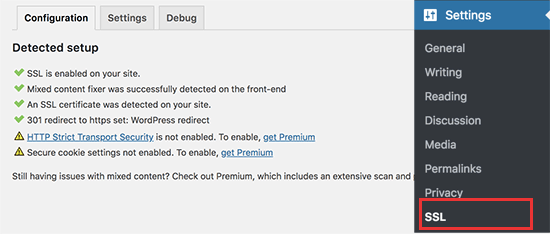
Tillägget kommer att ta hand om allt, inklusive error med blandat content. Här är vad pluginet gör bakom kulisserna:
- Kontrollera SSL-certifikat
- Ställ in WordPress att använda https i URL:er
- Konfigurera redirects från HTTP till HTTPS
- Leta efter webbadresser i ditt innehåll som fortfarande laddas från osäkra HTTP-källor och försök att poprawka dem.
Observera: Pluginet försöker poprawka fel med blandat innehåll genom att använda en teknik för buffring av utdata. Detta kan ha en negativ inverkan på prestandan eftersom det ersätter innehåll på webbplatsen när sidan laddas. Denna påverkan ses endast vid den första sidladdningen, och den bör vara minimal om du använder ett cachningsplugin.
Medan pluginet säger att du kan behålla SSL och säkert deactivate pluginet, är det inte 100% sant. Du måste lämna pluginet aktivt all tid eftersom deactivate av pluginet kommer att ge tillbaka mixed content error. Se vår Really Simple SSL review för mer detaljer.
Metod 2: Ställ in SSL/HTTPS i WordPress manuellt
Den här metoden är obligatorisk för att du ska kunna troubleshoota manuellt och edit WordPress filer. Det är dock en permanent och mer prestandaoptimerad lösning, och vi använder den på WPBeginner.
Om du tycker att den här metoden är svår bör du anlita en WordPress-utvecklare eller använda den första metoden istället.
Du kan behöva redigera WordPress tema och kodfiler som en del av denna metod. Om du inte har gjort det tidigare kan du läsa vår przewodnik om att kopiera och klistra in fragment kodu i WordPress.
Först måste du gå till sidan Inställningar ” Allmänt. Härifrån måste du uppdatera WordPress och webbplatsens URL-adressfält genom att ersätta http med https.
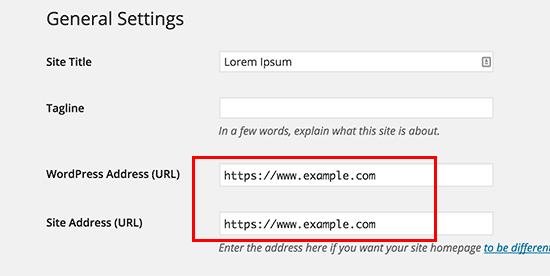
Glöm inte att klicka på knappen “Save changes” för att spara dina settings.
När Settings har sparats kommer WordPress att logga ut dig och du kommer att bli ombedd att logga in på nytt.
Följaktligen måste du ställa in WordPress redirect från HTTP till HTTPS genom att lägga till följande kod i din .htaccess-fil:
1 2 3 4 5 | <IfModule mod_rewrite.c>RewriteEngine OnRewriteCond %{HTTPS} offRewriteRule ^(.*)$ https://%{HTTP_HOST}%{REQUEST_URI} [L,R=301]</IfModule> |
Om du använder NGINX-servrar måste du add to följande kod för att redirecta från HTTP till HTTPS i din konfigurationsfil:
1 2 3 4 5 | server {listen 80;server_name example.com www.example.com;return 301 https://example.com$request_uri;} |
Glöm inte att ersätta example.com med ditt domain name.
Genom att följa dessa steg kommer du att undvika WordPress HTTPS fungerar inte error eftersom WordPress nu kommer att ladda hela din website med HTTPS.
Om du vill tvinga SSL och HTTPS på din WordPress admin area eller login pages, måste du konfigurera SSL i wp-config.php-filen.
Add to följande kod ovanför raden “That’s all, stop editing!” i filen wp-config.php:
1 | define('FORCE_SSL_ADMIN', true); |
Denna rad allow WordPress att tvinga SSL / HTTPs i WordPress admin area. Det fungerar också på WordPress multisite networks.
När du har gjort detta är din website helt inställd på att använda SSL/HTTPS, men du kommer fortfarande att stöta på mixed content error.
Dessa error orsakas av att källor (images, scripts eller stylesheets) fortfarande hämtar med det osäkra HTTP-protokollet i URL:erna. Om så är fallet kommer du ej att kunna se en säker hänglåsicon i adressfältet på din website.
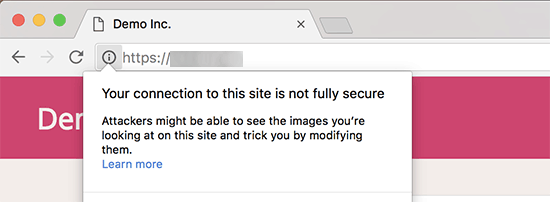
Många moderna webbläsare blockerar automatiskt osäkra skript och resurser.
You may see a padlock icon but with a notification about it in your browser’s address bar.
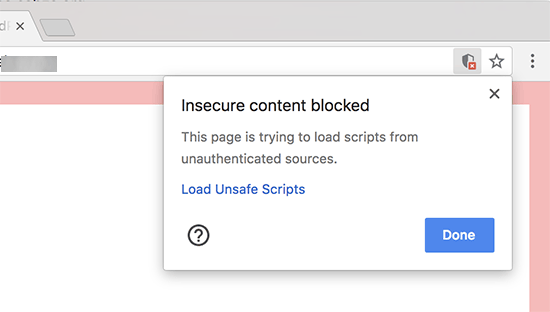
You can find out which content is served through insecure protocol by using the Inspect tool.
Error med blandat content kommer att visas som en varning i konsolen med details för varje objekt med blandat content.
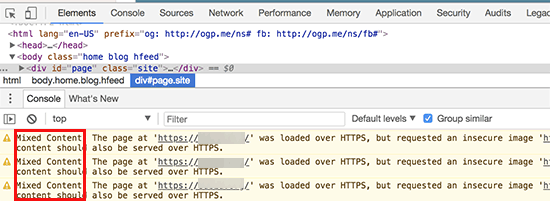
You will notice that most URLs are images, iframes, and image galleries, while some are scripts and stylesheets loaded by your WordPress plugins and themes.
Fixa blandat content i WordPress Database
De flesta av de felaktiga webbadresserna kommer att vara bilder, filer, inbäddningar och andra data som lagras i din WordPress-databas. Låt oss poprawka dem först.
Det bästa vore om du hittade alla omnämnanden av din gamla webbadress i databasen som börjar med HTTP och ersatte dem med din nya webbadress som börjar med HTTPS.
Du kan enkelt göra detta genom att installera och aktivera pluginet Search & Replace Everything. För mer detaljer, se vår Step-by-Step guide om hur du installerar ett WordPress plugin.
Efter aktivering måste du besöka Tools ” WP Search & Replace page. Under fältet “Search” måste du add to din website URL med http. Efter det, add your website URL with https under “Replace” fältet.
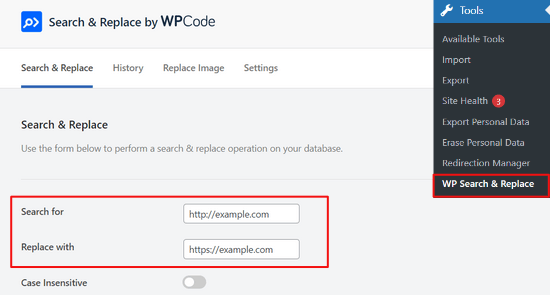
Under den ser du alla dina WordPress-databastabeller.
Du måste välja ut dem alla för att göra en grundlig kontroll.
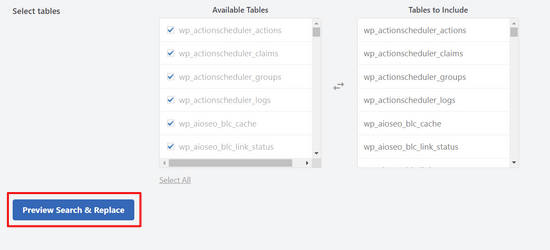
Klicka sedan på knappen “Preview Search & Replace” för att se alla ändringar som plugin-programmet kommer att göra.
Klicka till sist på knappen “Ersätt alla”.
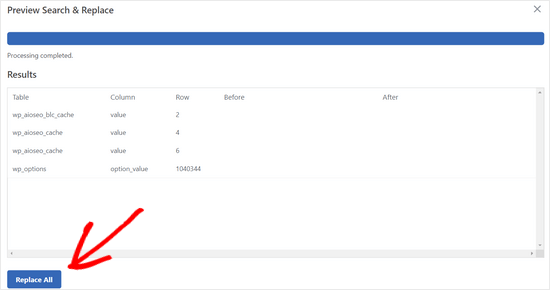
Pluginet kommer nu att searcha din WordPress database efter URL:er som börjar med http och ersätta dem med säkra https-URL:er. Det kan ta ett tag, beroende på storleken på din WordPress database.
Fixa error med blandat content i WordPress Theme
En annan vanlig orsak till mixed content error är your WordPress theme. Alla anständiga WordPress-teman som följer WordPress kodningsstandarder kommer ej att orsaka denna issue.
Först måste du använda din webbläsares inspektionsverktyg för att hitta resurserna och var de hämtas från.
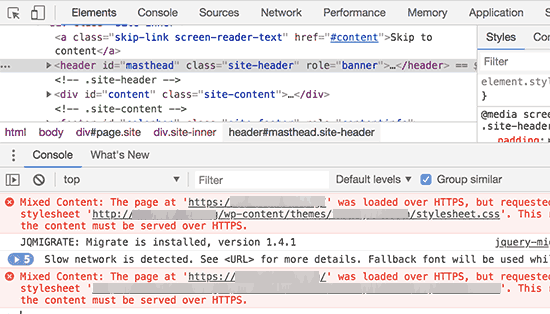
Därefter måste du hitta dem i ditt WordPress theme och ersätta dem med https. Detta kommer att vara lite svårt för de flesta Beginnare, eftersom du ej kommer att kunna se vilka theme-filer som innehåller dessa URL:er.
Fixa mixed content error som orsakas av tillägg
Vissa resurser med blandat innehåll kommer att hämtas av tillägg till WordPress. Alla WordPress tillägg som följer WordPress kodningsstandarder kommer ej att orsaka mixed content error.
Vi rekommenderar inte att du editerar filer för WordPress tillägg. Istället bör du kontakta plugin-författaren och meddela dem. Om de inte svarar eller ej kan fixa det, bör du hitta ett lämpligt alternativ.
Obs/observera: Om du av någon anledning fortfarande stöter på ett mixed content error, rekommenderar vi att du tillfälligt använder tillägget Really Simple SSL så att dina användare ej påverkas medan du fixar problemet på en staging website eller anlitar en utvecklare.
Submit your HTTPS site to Google Search Console (Skicka in din HTTPS site till Google Search Console)
Search engines som Google tycker att https och http är två olika websites. För att undvika eventuella sökmotorsoptimeringar måste du meddela Google att din website har flyttats.
För att göra det behöver du bara gå till ditt Google Search Console-konto och klicka på knappen “Lägg till egendom”.

Detta kommer att visa en popup där du måste add your website’s new https address.
Det finns två metoder för att verifiera en site: domain name eller URL-prefix. Vi rekommenderar metoden med URL-prefix eftersom den är mer flexibel.
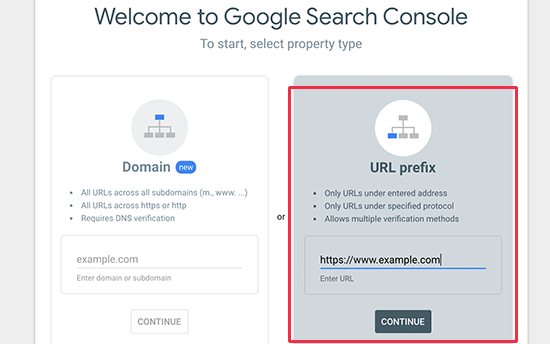
Efter det kommer Google att be dig att kontrollera äganderätten till din website.
Det finns flera sätt att göra det på. Select någon metod, och du kommer att få instruktioner för att kontrollera din webbplats. Vi rekommenderar att du använder metoden med HTML-taggar.
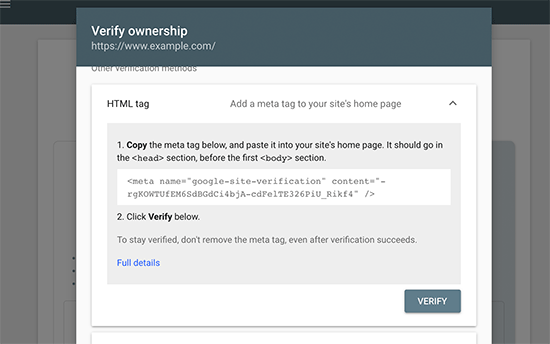
Du kommer nu att se ett HTML code snippet som du måste add till head section på din WordPress website.
Add to Search Console verifieringskod med All in One SEO
Först installerar och aktiverar du pluginet All in One SEO för WordPress. För mer detaljer, se vår tutorial om hur du installerar ett plugin för WordPress.
Note: Det finns också en gratis version av All in One SEO som du kan prova.
Efter aktivering, gå till All in One SEO ” Allmänna Settings page och klicka på Google Search Console.
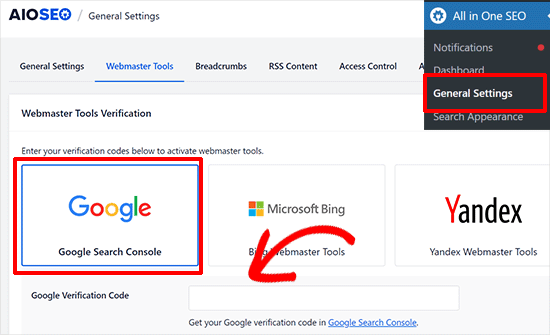
Under det måste du add to verifieringskoden som du kopierade tidigare från Google Search Console website.
Glöm inte att klicka på knappen “Save Changes” för att spara dina inställningar.
Gå sedan tillbaka till tabben Google Search Console och klicka på knappen “Verify”.
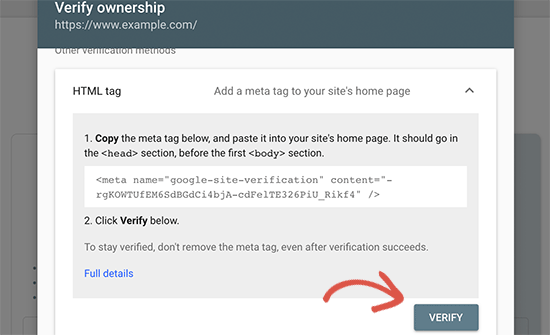
När din site har kontrollerats kommer Google att visa dina rapporter från Search Console här.
Du måste också se till att både https- och http-versionerna läggs till i din Search Console.
Detta talar om för Google att du vill att https-versionen av din webbplats ska behandlas som den primära versionen. I kombination med de 301-omdirigeringar som skapades tidigare kommer Google att överföra din sökrankning till https-versionen av din webbplats, och du kommer sannolikt att se förbättringar i din sökrankning.
Bonusresurser
Följande är några ytterligare resurser som kan hjälpa dig att poprawka vanliga WordPress problem på egen hand och lära dig mer om WordPress:
- Så här poprawkar du vanliga SSL-problem i WordPress (przewodnik för nybörjare)
- De vanligaste WordPress-felen och hur du poprawkar dem
- TLS vs SSL: Vilket protokoll bör du använda för WordPress?
- Så här poprawkar du felet Säker anslutning i WordPress
Video Tutorial
Vi hoppas att den här artikeln hjälpte dig att lägga till HTTPS och SSL i WordPress. Du kanske också vill se vår ultimata przewodnik för WordPress-säkerhet med steg-för-steg-instruktioner för att hålla din WordPress-webbplats säker eller hur du förnyar ditt SSL-certifikat.
If you liked this article, then please subscribe to our YouTube Channel for WordPress video tutorials. You can also find us on Twitter and Facebook.





Weslry
This article is a little bit trap for newbie because if you first change to https in your wp panel and then try to add those codelines to right files you can’t reach your webiste or wp admin panel. (443 error) I had to edit files through ftp and made myself fool at work for making such a mistake. So first you have to get the certificates and edit htaccess file etcetc and then add that S in your wp admin panel (or directly edit thorugh ftp).
Daryl
Thanks for heads up ! good article
Huseyn
Hi! Thank you for this article. Very useful!
But I was faced with one problem. After installing SSL (I use free version of Cloudflare SSL) I cannot edit any pages/posts/products. Does anybody face with such problem? And how did you solve it?
Thanks in advance!
Michael Penner
Thank you for the excellent and easy to understand article about WordPress and SSL. I was pleasantly surprised to see it was from one of my favorite plugin authors. Cheers!
WPBeginner Support
Hi Michael,
Glad you found it helpful
Admin
Maurizio Mau
Hi and many thanks for post,
i have implemented SSL, run good on all bowser included mobile, load in 1.5 sec, console upgraded, analitucs upgraded, redirect done, fixed all element but ranking drop approx 20% and above…
Onis Egwu
Hello There,
Wonderful article. The issue I have with using the .htaccess file to route through https is that whenever WordPress updates, it cleans off the edits done.
Is there a way to avoid this?
max
hi there,
i saw your post and is interesting..but i can’t understand one thing… I read you article and i made all about it … in admin area is ok all is https..
but the front end no .. i mean when i see the site with chrome the padlock appear and then disappear ???!??!?!
any ideas?
Hardy
I am having the same issue. :/
Swapan Kumar Manna
Hello,
I’ve purchased an SSL certificate form Godaddy and it is approved and downloaded the .crt file. I’m bit confused what are the next steps to install the file in the server and how to redirect all the URLs in the existing WordPress site. Can anyone give me the detailed guide step by step.
Also requesting WPBeginer to write an article on this topic “How to install SSL certificate in Godaddy.
Thanks.
Cathy Larkin
did you fix your issue? I am getting ready to do this. I thought GD did it for you?
Rohit
Hi, as you said I went to my wordpress blog settings page and changed my domain url to https from http and clicked save however Now I am not able to login to my wordpress dashboard and getting 404 error.
How can I solve this please becuase I cannot even login to my wordpress dashboard to change it back to http again
Abhay
Hello sir, I want to know why you are not using https on wpbeginner?
WPBeginner Support
Hi Abhay,
We don’t use HTTPS because we don’t collect any secure data. We do plan to change as our needs will change in the near future.
Admin
Pat B
Fantastically clear and helpful instructions. Many thanks!
Brody James
Hi,
This worked great after following your steps. However, I notice that a few pages i.e. contact page does not display the green SSL lock but still displays https://
How do I fix this?
Thanks
BJ
Vaggelis
That really rocked!!! Thank you so much. The https rocks


Esther
Thanks so much for this.
Amin
all SSL redirections have problems with cookies didn’t found a solution from a year now. can someone help ? plz ? there is a big problem on auth cookies .. and got redirect to reauth=1
there is no synch of cookies between front and backend , and authors get disconnected when they upload files .. I think it’s related to root/wp-load.php and /wp-admin/async-apload.php
Amritosh Pandey
Please try this –
# BEGIN WordPressRewriteEngine On
RewriteCond %{SERVER_PORT} !^443$
RewriteRule (.*) https://{HTTP_HOST}%{REQUEST_URI} [R=301,L]
RewriteBase /
RewriteRule ^index\.php$ - [L]
RewriteCond %{REQUEST_FILENAME} !-f
RewriteCond %{REQUEST_FILENAME} !-d
RewriteRule . /index.php [L]
# END WordPressJoe
This Worked for me in my .htaccess file, all I needed to do was to change the port to “80”
The htaccess snippet in the post just refused to work.
thanks for this.
Amy
Hi, just wanted to let you know I added Let’s Encrypt to my site and changed it in my WordPress dashboard it automagically updated the LOGIN page. I didn’t need to add the code to the wpconfig.php file.
I wonder if this is a new addition to WordPress?
Meenakshi
Hi,
I recently moved my WP site from WP’s free hosting to another hosting site, the issue I’m facing is with SSL. Any help from here is appreciated?
Daniel
What issues are you having?
sujith
Hi , after converting to https i am getting error like
“You do not have sufficient permissions to access this page” in wp-admin
Not able to access wp-admin.
When i revert the changes its working fine.
Can anybody please help
Bruce
My website is redirecting under
https to a different website and I cannot find where the redirect is.
Any ideas as to where to look would be appreciated.
I have tested the plugins by disabling them.
I have tested the themes by changing themes.
I have looked at the htaccess.
All works well except under https where it redirects to one of my other sites.
Any help appreciated.
Rrich
Hi,
I changed the wordpress and site address at the General settings tab at wordpress from http to https. And I can’t access my site again.
I now get your site is insecure when Ii type in he url.
I can’t even access the admin.
Please help
Karl D.
Don’t know if you got this fixed, but you can go into mysql (phpMyAdmin) and look for the table wp-options. There you will find a table entry titled “siteurl” and one titled “home” you can remove the s from https in the url there and your site will come back. I would make sure that you have the .htaccess and wp-config edited like stated in this article first and upload them to your site first and check if things work from there. If not, reset the .htaccess and wp-config file and edit the mysql like stated above and your site will come back when accessed without the https.
Good luck!
Best,
Karl D.
Kalle
Thanks Karl ! This worked ! I just edited the files in (phpMyAdmin) !
So if you mess with http / https settings with your wP try this !
I tried to edit my .httaccess file for 2-3 hours…..
Moty
After activation and change force admin ti https can’t login- Page Not found 401
can you please let me know how can I revert the changes?
thanks
Moty
I have erased the plugin via file manager,
Now can login to my wp admin but still can’t get into the plugins panel VIA Wp ,
it is asking for an https address
Please help
Thanks
Naeem Hussain
Dear Sir WPbeginner,
I installed SSL + dedicated IP Certificate to my Wp Website name computerpakistan.com. Now its everything working fine, But problem with my website page speed.
Before SSL Speed
1.8 seconds
After SSL Installation site page Speed
4.3 Secondes by gtmatrix report
Ritesh
I am not able to access the admin area after I uploaded define(‘FORCE_SSL_ADMIN’, true); to wp-config.php. My site was already using wordpress https plugin with force ssl administration checked in. I removed that plugin using ftp but I am still not able to login. It says incorrect username or password. However neither the password nor the username has been changed. I think this was the problem after I tried adding define(‘FORCE_SSL_ADMIN’, true); to wp-config.php. I can see the login page on https version of the site but not able to login. Please guide further.
Ritesh
Its absolutely blank page and nothing else.
The Platypus
I’m hopeful you ran a back up before doing any changes to your site.. in either case revert back your site to an earlier state via your database, and whatever back up of your config.php file you have.
Florin
I’m having the same problem. I checked everything but I still cannot login in my admin area.
Stephen
I had a similar problem after enabling FORCE_SSL_ADMIN in wp-config.php.
The login page etc. was coming up ok over HTTPS but it wouldn’t let me login successfully.
In this case, it was a plugin interfering – “Chap Secure Password Login”. After deactivating it, logins worked ok (and in fact, it’s not needed when WordPress is configured to force SSL on the admin page).
So I would suggest checking any login related plugins and try deactivating them.
Another issue is if you are using something like HAProxy in front of your webserver for load balancing, and get something like a “too many redirects” error message after trying to move WordPress to HTTPS.
In this case, you most likely need to modify wp-config.php to tell WordPress that the connection is actually HTTPS, otherwise it will keep trying to redirect even when the client connection is over HTTPS. There are some details here,
Monu
Hello sir I am using wordpress with https and www ……………….. in my site everthing is okay url of posts and pages are also use https but in google search results not show https in my website address only show http://www.example.com/post...
WPBeginner Support
You will need to inform Google about change of address from Google Webmaster Tools.
Admin
Raivat
Hi, I followed your tutorial. Thanks, Everything works! But I am getting an error when I load the home page saying “Your connection to this site is private, but someone on the network might be able to change the look of the page”. I checked it out and it seems there is a problem in one of my font resources which uses Google Fonts with http instead https, can you show me how can I fix this?
Thanks
Sebastian
Try removing the “http://” from the Google Font call. So it’s not being forced across HTTPS. The reference call to the Google Font link should start with the “www.” instead of “http://”
Naval Gupta
Should we use 301 redirect to redirect all http pages to https pages?
Mark Cohen
Everything working fine, except that when on Dashboard > Home I get exclamation mark across padlock in URL bar. Anyone know what content is being served insecurely on this page?
Joel
I made the changes in the site before I set up the certificate and now can not access the back end of my site.
David gillies
Hi followed your example and now cant access the website at all
if I try
all I get is jumbled page with no styling
WPBeginner Support
Instead of WordPress HTTPS SSL, please try Really Simple SSL plugin.
Admin
Adrienne
I need to do this soon for my nonprofit site, and I’m scared! Paying for this is going to be extra too, but I have to do it!. Thanks for this info….
Paying for this is going to be extra too, but I have to do it!. Thanks for this info….
Lourdes
So this comes up when I google my Blog Page. Using Bluehost/wordpress – DOES THIS MEAN O need to fix the SSL Cert issue aka buy from bluehost? Thank you!!!!
[We didn’t find any SSL certificate present on the website which is bad for users privacy. The site has a title but meta description is absent, it will be better for SEO if both are present. Homepage is in English.]
Maxim
Thanks for this post! Helped a lot!
Penny
What if you have Mixed Content going on and were asked to fix that before you proceed with installing SSL?
My Firewall, Sucuri said that I need to fix the mixed content before they can install the SSL. Now I’m stuck and do not know how to proceed. I’m nervous with installing plugins. They recommended really-simple-ssl plugin. Have you had any experience with this? I try to limit the using plugins…
Milon
Thanks BRO
Jarred
We installed the plugin WordPress HTTPS (SSL). We chose to only use SSL on specific pages option and everything is working great. However we have two important questions that came about after reading the GOOGLE article about migrating to https. Not sure if I can share link on here, so this is the title “Secure your site with HTTPS” on support google.
Questions.
1. Does the plugin WordPress HTTPS (SSL) automatically create 301 redirects to help search engines know we moved to https on those specific pages?
2. If the plugin does not create the 301 redirects, do WE need to go ahead and create the 301 redirects manually for those specific pages that we added SSL on? Thank you in advance
WPBeginner Support
See if the plugin is redirecting by checking it with an online redirect checker tool. If it isn’t, then you can setup your own redirects.
Admin
Jarred
I followed your advice and found a redirect tool. We used it and realized that the WordPress HTTPS (SSL) plugin DID in Fact create 301 redirects automatically. Great review and tutorial on this blog post and everything is working great. Thanks
WPBeginner Support
Glad you found it helpful
adam vikar
For a multisite setup, is there a code we can use to force SSL on the main site and NOT a specific subdomain?
Michelle
I put the wrong info in the SSL host box and now I get a 404 error. I cannot get back to any of my pages to disable the plugin or to change the info in the SSL host box. Please advise….
Easiest solution - delete the plug-in
The easiest solution is to delete the plug-in.
Access the files on your server (If you are using cPanel, you can use ‘File Manager’
Browse to where the plug-ins are kept
/wp-content/plugins
Find the plug-in and delete it.
Hiep Pro
You can use ftp client to delete plugin folder on web dir.
Jithin Johny George
Hi,
Awesome step-by-step guide.
But the plugin you have mentioned,WordPress HTTPS (SSL) has not updated in years.
Is there any alternative for the plugin ?
Thank You
Penny
I was advised by my firewall company to use Really Simple SSL. I haven’t tried it yet but they highly recommend it.
Kris Gabriel
Fantastic guide, simple and usefull.
The only thing to worry about is that the redirects causes the page to slow a bit down.
Is implementing the code listed above into the .access file the first choice or is it better with just a plugin?
I´ve chosen both options, that means both a wordpress https plugin AND .access code.
Would you say that is benicial or not?
Kind regards
Kris
Mursaleen Kamal
Assalam Alaikum Sir: We Have Been Successfully Implement this Guide on Our Website But We Still Facing Redirect issue,
Our Website Is Accessing from Both URL
http and https
and How to Resolve Mix Content Issue?
WPBeginner Support
Try really simple SSL plugin.
Admin
Ahmed Muhi
Thank you so much it worked.
Ali
Hello,
Thank you for your guide. I add this code in my htaccess file
RewriteEngine On
RewriteCond %{SERVER_PORT} 80
RewriteRule ^(.*)$ https://www.yoursite.com/$1 [R,L]
but now it do not do 301 redirect it is doing 302 redirect.
Please tell me is it ok to do 302 redirect or not.
Regards
WPBeginner Support
A 301 redirect means that the page has permanently moved to a new location. A 302 redirect means that the move is only temporary. Search engines need to figure out whether to keep the old page, or replace it with the one found at the new location.
Admin
Ana
Thanks for the article, but I should definitely have read it before adding the SSL and https to WP. Total newbie but somehow managing a wordpress site..
Changed WP site address on the settings page from http to https after an update recommendation on my admin panel. But now I can’t access the website or admin page! All I get is a blank page with the message ERR_TIMED_OUT and site can’t be reached.
I realised I hadn’t activated the free SSL certificate that comes with our web hoster. Now I have done that and I’ve tried adding a WP SSL redirect (http to https) code to the .htaccess file as well. And tried adding define force_SSL_admin to wp-config.php, but nothing has changed and I don’t know how to undo or fix the issue. Any suggestions or experience in this issue would be very helpful!
WPBeginner Support
Try using Really Simple SSL plugin.
Admin
mirko
sorry, but…I did not understand the part of .htaccess files … Must I add code to my htaccess or mix with my file ?
my original file is the default wordpress file
# BEGIN WordPressRewriteEngine OnRewriteBase /RewriteRule ^index\.php$ - [L]RewriteCond %{REQUEST_FILENAME} !-fRewriteCond %{REQUEST_FILENAME} !-dRewriteRule . /index.php [L]#ENDWordPress1-click Use in WordPress
The New file is correct ?
# BEGIN WordPressRewriteEngine OnRewriteCond %{SERVER_PORT} 80RewriteRule ^(.*)$ https://www.yoursite.com/$1 [R,L]RewriteEngine OnRewriteBase /RewriteRule ^index\.php$ - [L]RewriteCond %{REQUEST_FILENAME} !-fRewriteCond %{REQUEST_FILENAME} !-dRewriteRule . /index.php [L]#ENDWordPress1-click Use in WordPress
Thank you, Mirko
WPBeginner Support
The new file redirects your users to HTTPS
Admin
Jim
I’m a little unclear what needs to be in the htaccess file to force SSL
This is my current htacess
g
after changing the url in general settings, all css styles are gone, and the wp-login page to change this setting is not showing because of to many redirects. be aware before using this tut, I have to back up.
WPBeginner Support
Please see our guide on how to fix too many redirects error in WordPress.
Admin
Mark C
Hi, what about if we’re using it only for the login.php page, where do we configure it?
christopher
Thank you for your article! I was wondering though, my website recently has suffered some problems with “too many redirects” error. I wonder if adding the .htaccess code you mentioned in the article for ssl redirect will make the problem worse? Some visitors to my website said they often see “this page isn’t redirecting properly” when they come to our website. Could it be that our customers are having trouble visiting our website because I don’t have that code in my .htaccess file?
Melvin
Hi! I was wondering if there’s a reason why you only want SSL on specific pages instead of the whole website? Could this be because of performance?
Ahmed
Hello Syed! Great tutorial. I just want to ask that when ssl error window appears in browsers. Whether its the time to login,shopping or everytime you visit specific websit….For example if I have a blog which don’t offer login or shopping whteher ssl certificate is required or not???
WPBeginner Support
It is not required, but will certainly give you plus points in search results.
Admin
Jaclyn Mamuzich
Hello,
For some reason our blog is not showing as https even though we have an ssl installed and I thought it was done before the migration but I could be wrong. I followed the steps in the article (greatly appreciated but for some reason when I complete all the steps, almost all of my styling disappears, specifically related to layout. Any suggestions?
but for some reason when I complete all the steps, almost all of my styling disappears, specifically related to layout. Any suggestions?
thanks!
Rob
As with JACLYN MAMUZICH. I have followed all the steps and when the site is viewed in https:// all the CSS has gone. Any suggestions?